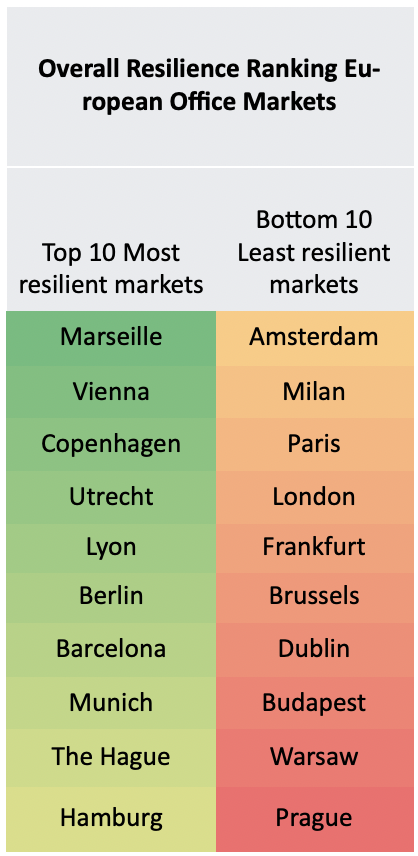Post-Covid work patterns will have a significant effect going forward in Europe.
During the Covid-19 lockdowns, the share of office employees working some time or usually from home more than doubled, from 28% in 2018 to 67% in July 2020 across the EU’s 27 countries (source: Eurofound). Of course, this increase has not gone unnoticed, as newspaper headlines emerged to debate the future of the office.
To add to this ongoing debate, we attempt to quantify the possible impact of home working across 25 European office markets using five key variables that reflect on different elements of the demand and supply equation. This will allow us to determine how resilient each market is to these expected changes from working from home (WFH).
“We expect the office stock to grow by an average of only 1.1% across our 25 markets over the next five years”
First of all, we consider traffic congestion data to derive a local market impact from home working (source: IRIX). During the lockdowns, congestion declined by 51% on average and we assume that when lockdowns are lifted, city congestion levels will return to normal. In the future, we assume that office employees in cities that have a higher congestion rate have more incentives to increase their home working than elsewhere. We take this estimate together with the reduction in office space per employee over time (reduction from 19sqm in 2003 to around 16sqm in 2019 on average in Europe) and the forecasts of office using employment.
Based on this, we can derive a city level office employment growth estimate while controlling for the future increase in home working for each city.
Second, we consider the availability of office (vacancy) space within the market. This makes sense, as markets with high availability will be more vulnerable to absorb shocks than low available markets, as the latter should be better at absorbing shocks.
Third, we consider the projected growth for the office stock. A significant development pipeline can exuberate the negative impact of home working. In context, we expect the office stock to grow by an average of only 1.1% across our 25 markets over the next five years. Results vary widely, as CEE markets show much higher increases in stock amplified by above average vacancy rates as well. This should make CEE markets more vulnerable to increased WFH in future.
As our fourth driver, we consider office worker cost efficiencies. This is estimated by taking the ratio of the gross value add per office employee to the occupancy costs. The rational here is that cost-efficient locations should be more resilient against market shocks, like increased WFH.
Lastly, as our fifth key indicator, we consider the demand elasticity which shows how sensitive occupied stock has been to changes in office-related employment in the past. The higher this elasticity, the bigger the possible negative impact from declines in demand.
To compile our resilience scores, we weight the above outlined five variables according to our judgement of their relative impact.
In the overview below, we highlight the resilience scores (most resilient green to least resilient red). Our results show that regional European office markets, such as Marseille, Vienna, Copenhagen and Utrecht, are expected to be more resilient. The reason for these cities to be more resilient can be related to a balanced supply and demand outlook combined with a high level of cost efficiencies.
Figure 1: Resilience scores

Source: AEW Research
In contrast, the home working trend is a bigger threat in CEE markets and some of the gateway cities, such as Frankfurt, London and Paris. In London, for example, we see a high vacancy level combined with a more structural impact from Brexit and increased home working. This is further helped by London’s high office occupancy costs relative to output per employee. The limited development pipeline outlook for London is not expected to completely offset the aforementioned.
Three of the top 10 resilient office markets are in Germany, which is mostly due to the low traffic congestion and solid office worker efficiencies.







